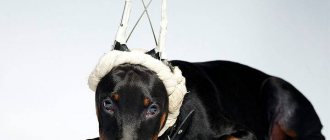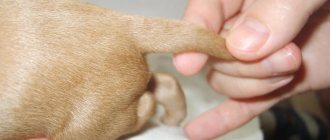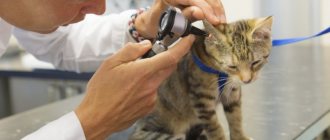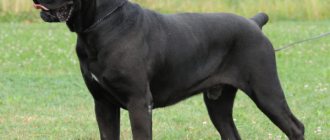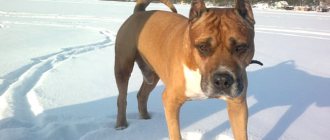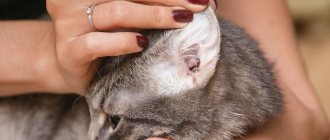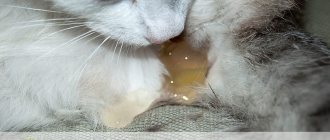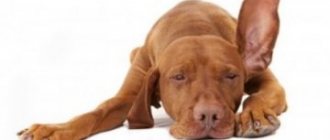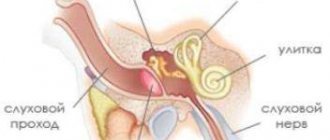One of the distinguishing features of the magnificent and graceful Doberman is its “candle” ears (cropped and set high above the head). A Doberman with undocked ears, according to many, loses all the breed's charm and menacing appearance. According to the standard, Doberman puppies have their tail docked on the second or third day of life, and after two to three months, their ears are docked. This breed was created by Friedrich Doberman to protect animals from broken tails and torn ears in a fight if the dog had to protect the owner and property.
Several years ago, European animal rights activists raised a difficult topic, in particular, prohibiting docking of tails and ears in many breeds: boxers, Great Danes, Staffordshire terriers, miniature pinschers, Dobermans . In many countries, docked dogs are not allowed at exhibitions; in Russia there is no such practice yet. In the text we will talk about why some parts of a dog’s body are prohibited from docking, consider the advantages and disadvantages of the procedure, cover the process of docking a Doberman’s tail and ears, and the most effective and popular schemes for setting up ears after surgery.
Doberman with undocked ears: pros and cons
Why is cupping performed?
Beginning dog breeders and simply curious people often wonder why dogs have their tails cut and their ears trimmed. Since ancient times, representatives of fighting, herding and hunting breeds have been subjected to a similar procedure. The purpose of docking is to minimize the risk of injury during a hunt or fight.
Today, after most breeds are practically not used for their intended purpose, many breeders still continue to produce puppies in the form familiar to everyone. And the point is not only that animals with long tails and ears hanging on cartilage stand out from the usual image of their appearance. It is believed that docking is a unique method of protecting dogs from the same injuries during battles and wounds. Doberman Pinschers with ears installed after trimming are much less susceptible to the occurrence of various neoplasms, the development of tissue necrosis and ulcers.
Interesting! Representatives of the World Society for the Protection of Animals decided to deviate from the usual standards of appearance, recognizing docking as inhumane. In countries including Germany, England, Austria, Holland and Scandinavia, docking is prohibited.
Is there a difference between American and European Dobermans?
Representatives of the American variety are characterized by:
- gullibility;
- affectionate temperament;
- elegance, sophistication;
- smooth line of the muzzle, lighter eyes;
- long, with a refined bend, neck;
- weaker bones.
The color is lighter, with wide tan marks. This type is considered graceful and skillful. Their European counterparts are known for their differences:
- wariness of people;
- large in size, with a muscular figure and deep chest;
- a clearly defined head line, a strong lower jaw;
- a strong bone skeleton, a less toned stomach;
- compact rather than long body.
Important! European black and brown Dobermans have rusty red markings. The appearance suffers a little due to the undocked tail and ears, which has led to a decline in interest among lovers of four-legged animals.
Difference between American and European
Price
The younger the Doberman is, the cheaper docking costs. Puppies up to a month old can have drooping ears installed for 500-1000 rubles. The price of the operation for puppies up to six months is 2000-3000 rubles.
The veterinarian can come to your home with tools and medications. In this case, the cost of trimming the skin increases by 1000 rubles. The final amount is also influenced by the dosage of anesthesia, the qualifications of the doctor and the prestige of the clinic.
In our country, the Dobermann, which has an undocked tail, differs in appearance from its brothers in the brood. Why is this part of the dog’s body cut off? When an adult animal wobbles, it can injure itself on bushes, trees, or furniture. The likelihood of other dogs biting this protruding area increases. The price of such cupping is 3000-5000 rubles.
At what age
Most breeders do not recommend delaying the operation. The animal will best tolerate such an intervention at the age of 2-3 months. Ponytails can be trimmed much earlier - in the period from 3 to 10 days after birth, with ears it is a little more difficult.
Why you shouldn’t postpone manipulation until later is because the older the dog, the faster its blood circulation. In older puppies, the wounds take much longer to heal than in those whose ears were cut at 2-2.5 months.
Important! The operation should be abandoned if the puppy is changing teeth, is sick, or has just had a vaccination.
Post-procedure care
A docked tail requires virtually no maintenance, especially if the operation was performed on a puppy. It is enough to treat the stump with an antiseptic and antibiotic solution and apply a sterile bandage. After 5-10 days, the stitches will tighten and the tail will heal.
After ear cropping, it is important to follow all your veterinarian's instructions. If restless behavior is noticed, a painkiller is injected.
Before healing, it is better to put an Elizabethan collar on the Doberman. The seams are treated daily with hydrogen peroxide and brilliant green or streptocide. You should also remove scabs on the edge of the ear: soak them in peroxide and clean them off with a cotton pad.
After 10-14 days, the sutures will be removed, then you can begin to install the ears (3-4 days after removal). To speed up healing (improve blood flow), massage the shell with your thumb and forefinger along the edge from bottom to top.
How to prepare
The most important thing in ear cropping is choosing a competent veterinarian. If the breeder himself is engaged in trimming the tails of Doberman puppies (he is looking for someone who will do this), then their new owners have to deal with the issue of bringing the ears into proper shape.
The veterinarian whom you entrust to trim and set your puppy’s ears must be competent, experienced and careful. The staging process is practically a piece of jewelry, the results of which will determine the dog’s future appearance.
Important! The puppy should be dewormed a few days before the visit to the clinic. Before the manipulation itself, you should not feed him. Two hours before anesthesia, the baby Doberman is also not given water.
Possible complications
Wound healing occurs within 1-2 weeks. After this, the dog needs to be shown to a veterinarian, who will assess the animal’s condition.
The following complications may occur during rehabilitation:
- Bleeding. It occurs more often in adult dogs, especially after injury to a scar that has not yet healed. Stops with veterinary pencil or powder.
- Scars and seals. They do not interfere with the dog, but affect the exterior. In puppies under 2 weeks of age, such complications almost never occur.
- Inflammation. Occur after infection gets into the wounds. Requires veterinary treatment.
If you properly care for your puppy after surgery, there will be no problems. Complications occur more often in adult Alabais - another argument against docking after 2 weeks.
Preparing for surgery
Before surgery, it is necessary to take a blood and urine test, undergo an x-ray and an ultrasound. The veterinarian will prescribe anthelmintic drugs, if necessary, 2 weeks before the procedure. The day before surgery, the dog should not be fed or given anything to drink as before. The amputated area is marked in advance and the hair is shaved off.
Cat with big ears: examples of breeds
It is mandatory to measure the temperature every half hour or hour. It should not exceed 39 degrees.
Note! Only a completely healthy animal can be docked.
How it goes
A puppy brought by its owner for ear trimming is given anesthesia. Clamps are installed on the cutting line. After this, the doctor uses a special device to remove 2/5 of the ear tissue.
Important! Proportions must be strictly observed, otherwise in the future the dog will look ridiculous with a disproportionate head.
Sutures are placed on the resulting wound without touching the cartilage. If you accidentally touch the cartilage with a needle, the ear will be disfigured. The second ear is also treated using the same proportions.
Types of colors
- Black-brown . The main color of the coat is dark brown, the color of dark chocolate.
- Chocolate . The dog's fur is a lighter milk chocolate color. The presence of a tan is also mandatory, since without it the Doberman will no longer be considered a purebred.
- Red-brown . With this color, the Doberman's coat has an intense reddish-brown color, which can also be described as chestnut. The absence of a tan puts such a dog outside the breed.
- Brown with white spots . You can also see dogs of this breed with small white spots scattered throughout the body. Even with tan, this color is considered a serious fault.
Is it necessary to dock the tail?
The tail is an important organ of the dog, which is involved in coordination of movements and body control.
With the help of the movements of this limb, the Doberman expresses its feelings and mood. Sweeping movements indicate that the dog is in a friendly mood and ready to play, or, conversely, expresses dissatisfaction. If the tail is tucked, the pet experiences discomfort and even fear.
Several centuries ago, Dobermans had their tails docked as protective dogs, because... this part of the body was subject to constant trauma. Over time, the procedure began to be carried out purely for cosmetic purposes, to maintain the appearance of the breed.
IMPORTANT!
Under new European standards, tail docking is considered human cruelty and an inhumane procedure. Therefore, many owners began to refuse surgery so as not to expose the animal to stress.
Gradually, all countries are introducing a ban on participation in competitions and exhibitions of tailless individuals. This was another reason why owners stopped thinking about docking their pet.
What to do next
Proper care of a cropped ear is the key to a healthy and attractive Doberman. The first thing to do after surgical manipulation is to put the remaining part into the desired shape. Gluing is done using adhesive tape. To do this, cut two strips of 10 cm and four of 30 cm in length. A cotton swab is inserted into the cleaned ear and “horns” are formed with adhesive tape.
Important! You can remove the plaster structure no earlier than after 2 weeks. If during this time it leans or falls apart, the performance must be done again.
Shaping the ears
From birth, the ears of a dog of this breed are of medium length and drooping. A Doberman puppy can easily be called “lop-eared.”
It is logical that after the cropping procedure the ears will not immediately “stand up” - since the cartilage has an inclined shape, it needs to be fixed in the postoperative period to give it a permanent shape.
To create perfect ears, use a special crown frame , which you can purchase or make yourself from wire. The pet's ears are sealed with a plaster to the top of the crown; the dog will wear this design for about two weeks with a break of an hour or two.
Next, the cropped ears are glued without a frame with a “tube”, and the pet walks with the resulting “horns” for another 3-4 days.
Origin story
The Doberman is a relatively young breed; it was registered only in 1880. It appeared thanks to the efforts of Friedrich Dobermann, a policeman from a small German town.
Friedrich Louis Doberman was born in 1834 in the city of Apold. He was a rent and tax collector. The man's occupation forced him to always have a reliable four-legged companion nearby. Disillusioned with many breeds, Doberman decided to breed “his own.” Friedrig dreamed of creating an ideal assistant - a dog with medium height, smooth hair and quick reaction, a sharp mind and adequate anger.
Selection work began by 1860. Unfortunately, no records have survived. Many experts considered the Doberman a arrogant amateur, but his works in the form of large, smooth-haired dogs with docked ears and tails quickly gained popularity. Presumably, many other breeds participated in the creation of the Doberman, including the Bosseron, the Old German Pinscher, the Rottweiler and some hunting dogs.
It is interesting that at first Dobermans were called Thuringian Pinschers, and only after the death of Friedrich Dobermann the breed was given a name after the name of the founder. As an independent breed, Dobermans first appeared at an exhibition in 1863 in Hamburg, Germany. In 1876 a stud book was opened for them. In 1894, the breed was renamed from the Thuringian Pinscher to the Doberman Pinscher. And since 1949, the dog has become simply a Doberman.
Video review about the Doberman dog breed:
Tips for choosing a Doberman puppy
When choosing a Doberman puppy, you should first identify a reliable breeder. He must have documents for both parents - a male and a female. Only if you have a veterinary passport, pedigree documents, a certificate of origin and a mating certificate can you begin to choose.
Before reaching the age of six months, the breeder must issue a certificate for puppies from the entire litter, which is then changed to a pedigree at the Dog Breeding Federation or a canine center.
Photo of Doberman Pinscher dog
You should only choose an animal with obvious signs of the breed - one of two standard colors, with an appropriate exterior that matches the characteristics of the breed.
Puppies from a litter with a small number of individuals are always distinguished by greater health. Babies born first are always larger and more active. At the same time, you should pay attention to the following signs of health and conformity to the breed in young Dobermans:
- soft belly;
- smooth wool;
- wide jaws;
- square body shape;
- strong, pronounced bone structure;
- massive strong back.
To choose a Doberman pet with 100% confidence, it is better to invite an experienced dog handler.
Character
The Doberman has a very unique character; it is not like many other breeds. He will protect the owner at the cost of his life, but at the same time he can be sentimental, he is aggressive, always vigilant and ready for a fight at any moment, but at the same time he can selflessly fool around in the clearing with the neighbor's puppy. This is a reliable, intelligent guard and a completely devoted friend and companion to the owner.
Anyone who enters a house in the absence of the owners is considered a potential enemy. Dobermans are hot and impatient, they are always ready for a swift attack, but at the same time they are aware of their strength and have a subtle mind, they know how to analyze and differentiate situations. Dobermans feel their mood very clearly and are rarely pushy. This is a fairly temperamental breed of dog, but sudden mood swings are not typical for them.
A well-bred Doberman is not a bully, he is not timid, but he will not show aggression unnecessarily.
The Doberman is a ferocious, quarrelsome and vicious dog for an ill-wisher, but in the family it is a good-natured, sweet and affectionate creature that treats children well and kindly. Of course, provided that the dog has been familiar with children since childhood and is well socialized. Dobermans become very attached to members of their “pack”, but it is important to take into account and respect his interests.
It is worth noting that Dobermans can be very different from each other. So, one dog will be attached to a specific person, and the other dog will be oriented towards the whole family. Some Dobermans, depending on their upbringing, can be more aggressive, while others are the opposite. Much depends on the conditions in which they grew up and, of course, their upbringing.
Interesting Facts
In various surveys, the breed consistently ranks among the 20 most popular. And one of the most famous representatives of the breed is the legendary Doberman named Tref, who served in the police in St. Petersburg at the beginning of the twentieth century. This unique dog has helped solve more than 1,500 crimes.
Gracefulness, royal dignity and power are similar to Great Danes and Dobermans. Keeping such dogs requires time, effort, financial expenses, as well as certain personal qualities from the owner. For a pet, he must serve as an unquestioned authority and be able to build emotional contact.
Advantages and disadvantages of tail trimming
Possible negative consequences of tail docking include:
- weakening of the dog's motor skills;
- disturbances in the functioning of the genitourinary system;
- the occurrence of problems in the dog’s communication with other pets and dogs;
- manifestation of causeless aggression.
NOTE!
It is worth noting that the above problems do not always occur, and there is no scientific evidence of their direct connection with cupping.
The biggest disadvantages of the procedure are:
- unpleasant sensations in the pet before and after surgery, bleeding from the wound during subsequent movements of the tail;
- every animal at any age whines and squeals during the procedure and calms down only after a few minutes.
Among the advantages, one can only highlight the maintenance of the usual appearance of the Doberman , which meets the standards, although at present this issue is controversial.
Opinion of animal advocates
Animal advocates consider this procedure absolutely useless and traumatic for the animal. In many countries, including the homeland of Dobermans, a ban on docking has been introduced. Why do Dobermans have their ears and tail docked? To provide a person with visual pleasure. And for this, the dog must endure pain and discomfort.
Note! The docking procedure is the owner’s desire. Therefore, before the operation, you should think carefully about whether it is worth exposing your pet to stress for the sake of its usual appearance.
Dobermans
The cupping procedure is a responsible and delicate job that requires skill and professionalism. Success directly affects the future fate and health of the Doberman. If the owner is not so important about appearance, then there is no need for the Doberman to have his tail and ears cropped. The animal will not gain any abilities after the procedure. Cropped Dobermans are similar in appearance to Pinschers. Dobermans' long ears set them apart from other breeds.
Examples of docked and undocked dogs of different breeds
Central Asian Shepherd Dog (Alabai)
An example of an undocked dog of the Central Asian Shepherd breed.
An example of a docked dog of the Central Asian Shepherd breed.
Doberman
An example of an undocked Doberman dog.
An example of a docked Doberman dog.
Pit bull terrier
An example of an undocked pit bull terrier dog.
An example of a docked pit bull terrier dog.
Giant Schnauzer
An example of an undocked Giant Schnauzer dog.
An example of a docked Giant Schnauzer dog.
miniature pinscher
An example of an undocked miniature pinscher dog.
An example of a docked miniature pinscher dog.
Method for setting up Doberman ears after cropping (with video)
One of the effective ways to set the ears of a Doberman is using foam rubber.
How to install Doberman ears using this method? First of all, the ears must be clean, that is, there should be no traces of blood on them; to do this, you need to carefully rinse it off and dry the wet areas with a hairdryer so that they are completely dry.
Before placing the ears of a Doberman puppy in this way, prepare a piece of foam rubber 5 cm wide (preferably soft, which is used for upholstery), a wig ribbon 2.5 cm wide (it can be purchased at stores that sell wigs), an adhesive plaster 1 and 2.5 cm.
The foam rubber is cut in the shape of a small wedge, so that the length of the base corresponds to the distance between the inner edges of the base of the ears, and the height is slightly greater than their length (for this they should be freely raised up). The base of the wedge should not be straight, but should match the shape of the puppy's head, so it should be slightly concave. Now you need to take wig tape that is sticky on both sides and wrap it around the foam. Having done this, place the foam rubber on the puppy’s head so that it sticks, and glue the ears on the sides (with the back surface so that the inner surface faces outward). Make sure they are positioned symmetrically, pointing straight up, and the cut edges are well aligned. While you apply a centimeter-wide patch from the base of the inner surface of the ear to its apex, and from it to the top and base of the other ear, the assistant should hold them upward. Now take a 2.5 cm wide patch, place it on the inner surface of one ear, glue it to the foam rubber in front and also attach it to the second ear. The resulting bridge should be located midway between the tips of the ears and the top of the skull.
With this method of setting the Doberman's ears, the foam rubber stays well on the head until the ears are completely healed, in addition, they are well stretched and straightened. When you need to remove the foam, you can do it without difficulty.
Regardless of the method, make sure that there is no inflammation, otherwise the ears will not stand up correctly or will not stand up at all. The use of foam rubber is more acceptable for the puppy and is easier for him to tolerate.
The video “Setting the Doberman's ears” shows how to correctly perform this procedure:
Disqualifying faults
Deviations that may lead to disqualification of an animal at a canine exhibition are presented:
- obvious perversion of the sexual type;
- different eye colors or yellow irises (like birds of prey);
- incorrect bite placement - pincer-shaped, with a protruding or recessed jaw, with incomplete dentition;
- unilateral or absolute cryptorchidism - the absence of one or both testicles in the scrotum;
- white spots (marbled, spotted individuals), wavy and long hair (on the body or in the form of a cap on the head), sparse coat or baldness.
Important! The height and weight of the Doberman plays an important role: deviations from the accepted standard lead to disqualification. How much can a Doberman weigh: from 35 to 45 kg.
Appearance
True fans of this breed are confident (and, it must be said, quite rightly) that the Doberman Pinscher is the standard of beauty in the canine world. The animals have a spectacular appearance, harmonious build, a high level of intelligence and a superbly developed protective instinct.
The modern Doberman is a dog of above average height: males reach 72 cm at the withers, weighing around 45 kg, females are slightly smaller: 68 cm, weighing no more than 35 kg. The physique of these animals is dense, strong, muscular, but not as massive as, for example, a Rottweiler. Representatives of the breed are endowed with an elegant, chiseled silhouette. The coat is silky and smooth. It only emphasizes well-developed muscles. The breed standard allows for brown or black and tan coloring.
Conditions of detention
Dobermans love physical activity, so they need many hours of walks and runs. In winter, it is worth purchasing warm clothes for them, because their wool does not contain undercoat, which warms the animals.
Dobermans are distinguished by fairly good health. However, you need to carefully monitor your dog's diet. Despite the fact that representatives of the breed have a stable digestive system, gastric volvulus often occurs, which is typical for large dogs with a wide chest.
Nutrition
Dobermans are quite unpretentious in their diet. If you decide to give preference to natural food, then you should not forget about meat as the main source of protein. Meat products should make up half of the entire diet, and in some cases (intense physical activity, cold season, etc.) 75% of the entire menu. It is impossible to raise a healthy and active dog on cereals alone. The diet must include vegetables, fruits, herbs, dairy products, eggs and fish. Another option would be to feed a balanced dry food. Portions must be calculated based on the weight of each individual dog.
